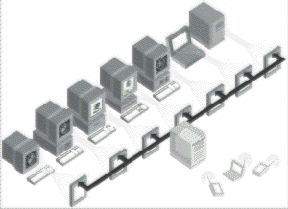
As we briefly discuss the different network operating systems and application servers, we come to Citrix WinFrame, which supports thin-client/server computing. Citrix WinFrame offers yet another type of application server specifically designed for use in a thin-client/server architecture.
WinFrame builds on Windows NT and adds multiuser capabilities.
WinFrame is a multiuser Windows-based application server that’s built on Windows NT Server version 3.51. As I mentioned in Chapter 1, applications execute on the server and are accessed using universal, thin-client Independent Computing Architecture (ICA) software that works in conjunction with the WinFrame multiuser application server software for display on dedicated thin-client devices or over local area network (LAN), wide area network (WAN), Internet, or dial-up connections. The local de-vice sends mouse clicks and keystrokes to the server, with display transmitted from the server to the local device. The thin-client architecture provides users with consistent, high-performance, and universal access to any type of application, including MS-DOS–based applications, Windows 16-bit and 32-bit appli-cations, and client/server applications, regardless of available bandwidth or client hardware. The multiuser application server design provides IS managers with an economical and manageable way to deliver applications across an extended corporate network or public Internet. The WinFrame application server configuration is shown in Figure 2-2.
FIGURE 2-2
The WinFrame application server configuration

The thin-client/server model functions similarly to an n-tier client/server application that has been partitioned such that all business logic executes on intermediate application servers, leaving client workstations to display the user interface, with databases residing on file servers. With the thin-client/server architecture, however, the actual execution of display services also occurs on the server. IS managers who are familiar with UNIX will recognize this approach’s similarity to the X Window System, which centralizes business logic and data access for UNIX applications. In contrast to the X Window System, the thin-client/server architecture that uses WinFrame application servers can run 16-bit and 32-bit Windows-based applications with a GUI that’s familiar to users.
The thin-client/server model lets the IS department deploy a single copy of the mission-critical application at a central site in the enterprise network. Local and remote clients, in turn, connect to the central application via LAN, WAN, or dial-up connections. In the thin-client/server model that uses WinFrame, since all ap-plication execution takes place on the server, you can use almost any device as the client machine, including a very low-end PC.